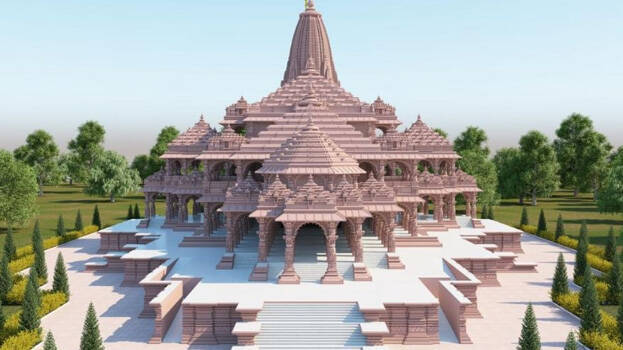

Each of us born in the lap of Mother India and brought up in the cradle of Indian culture is infinitely fortunate. Culture was born when the primitive man lend himself to the changes. In India that culture grew into Sanathana Dharma. Indians see Sree Rama, the Perfect, as the epitome and embodiment of that culture. For Indians he is the ideal hero who teaches everyone to observe daily routine and chores through Mercy, Devotion, Respect, Alertness, Humility and Love. But the history of invasion tells us how Rama was ousted from where he was born. When the Indian Prime Minister Sri Narendra Modi laid the foundation for the Sree Rama Temple in Ayodhya on August 5 in 2020, it was the materialization of a dream his devotees cherished for centuries. All exhortations to build this temple had lead only to controversies and ensuing violence. When the foundation stone was laid, a centuries-long wait also came to an end.
"As the building of this temple is initiated, history is not only made but repeated as well. Sree Rama's Triumph, Sree Krishna's lifting the Govardhan Mountain, Chatrapati Shivji establishing Swaraj and Gandhiji's Freedom Struggle were all participated in by the poor, the down-trodden, as well as the Dalits and Tribal clans. The building of the Sree Rama Temple is also done with the participation and cooperation of the ordinary people," said Prime Minister Modi after he laid the foundation stone.
Nowhere in the world can we see a country where people of different creeds such as Hinduism, Islam and Christianity live harmoniously like they do in India. Violence has erupted only when terrorists and people with vested interest tried to curdle this harmony. People who fall their propaganda often forget that nowhere in the world do the community with the majority consider and treat the minorities with as much equality and tolerance as they do in India. In any other country parochial-divisive powers do have their sway. Those who poured in either though immigration or invasion will forever be second-rate citizens. To see an example of this kind of segregation and discrimination, one only has to look at Pakistan, India's neighbouring country and see how those who migrated to Pakistan from India, taking it for a country of one's own religion. But India which thinks in the line of universal brotherhood there are no foreigners or outsiders. Sree Rama is the incarnation of this culture and this it is the divine ideal that we uphold for all the world to see and emulate when we erect the Sree Rama Temple.
The controversy over the ownership of Babri Masjid which was built in 1528 by Babar, a Mughal who invaded India and established the Mughal Dynasty, began in the mid-19th century. As Nirmohi Aghada claimed that the mosque was built after demolishing the Ram Temple in Ayodhya, clashes began in 1850s. In 1885, for the first time, the Ayodhya land ownership claims came before the court but the petition seeking permission to rebuild the temple was dismissed by the Faizabad court. In 1950 Ram Lalla's devotee Gopal Visharad went to court with the claim that the Hindus had the right to offer Puja. While the arguments and counter arguments continued in the court, on November 9, 1989, Vishwa Hindu Parishad laid the foundation stone for rebuilding the Rama Temple. Exactly thirty years later, on November 9, 2019, the Supreme Court's Constitution Bench gives permission to rebuild the temple at Ayodhya. Meanwhile quite a few painful incidents tarnishing the soul of the country occurred. In 1992, the mosque built by Babar, the founder of Mughal Dynasty, was demolished. The violence that ensued reportedly killed over 2000 people. The Ram Janmabhoomi issue, a painful and festering wound on Mother India's very soul has been healed by the historical verdict from the Supreme Court. As the court gave permission to build a Sree Rama Temple where the Hindus believe Sree Rama was born and 5 acres is allotted to Sunni Waqf Board to build a mosque at another place right in Ayodhaya, a permanent solution is reached. Finally, the foundation stone for the temple has been laid.
The temple coming up at Ram Janmabhoomi should be a symbol of unity and universal brotherhood. Each stone mounted there should bind the Indian psyche to its cultural roots. As the abode of Sree Rama, the embodiment of human values become a sacrosanct which proclaims mercy, compassion and justice, we would have traversed much distance on our way to Rama Rajya. The temple that rises at Ram Janmabhoomi should shine as a shrine which reflects the integrity and the unity in diversity of India.